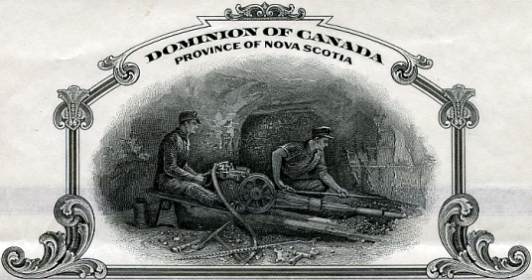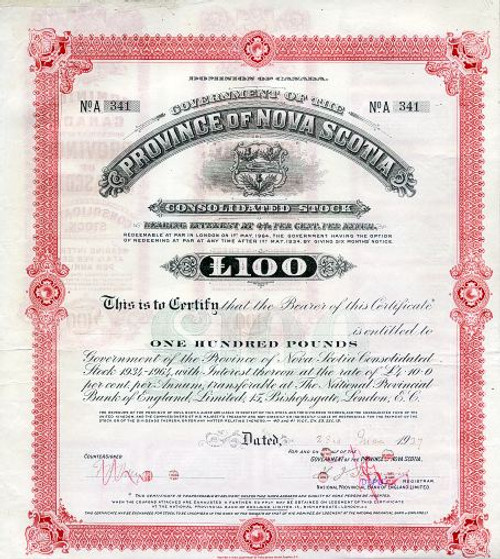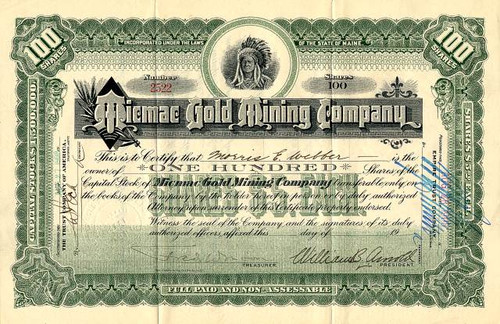Beautifully engraved certificate from the Dominion Coal Company, Limited issued in 1934. This historic document was printed by the Canadian Bank Note Company and has an ornate border around it with a vignette of men working in a mine. This item is hand signed by a Company officer and is over 70 years old. 
Certificate Vignette Dominion Coal Company By the 1870s the leading operators saw that, besides protectionist measures, a consolidation of the more important leases and colliery operations was evident. The idea was conceived of amalgamating all the major independent companies of the Sydney Field, modernizing them and replacing the lost American markets by increased sales to the Central Canada market, especially in Montréal. After a visit to Boston by the Nova Scotian premier, W.S. Fielding, in 1893, the Henry M. Whitney syndicate of Boston and other Nova Scotia businessmen united the Gowrie, Schooner Pond, Clyde, Glace Bay, Caledonia, Reserve, Lorway, Emery, International, Bridgeport, Gardiner, Lingan, Victoria, and other small collieries into the Dominion Coal Company. This new company did not, however, contain the operations and coal leases for the north side of Sydney Harbour, which were retained by the General Mining Association until 1900, when they were sold to the Nova Scotia Steel Company of New Glasgow. With the blessing of Premier Fielding, the provincial government, sorely in need of new revenue, accepted an increase in the coal royalty from 10 cents to 12.5 cents per ton, in addition to an annual fixed royalty for the granting of a 99 year lease. The capital for the purchase of the existing leases was done by bond issue. Thus, a near-monopoly was created without any real investment by the promoters. Prior to World War 1, the Dominion Coal Company occupied "a preponderating position in the Canadian Coal trade." By 1912, the Company had 16 collieries in full operation and its production accounted for 40 percent of Canada's total output. The Dominion Iron & Steel Company Ltd. was also developed in Sydney by Whitney and his financiers in order to provide an outlet for the slack coal which was the result of screening. It should be noted that the Dominion Coal Company and Dominion Iron and Steel Co. Ltd. would become subsidiaries of the Dominion Steel Corporation. In 1901, Whitney sold control of the Dominion Coal to a prominent Montréal capitalist, James Ross, and during this time the Dominion Iron and Steel Co. Ltd. was also delivered to Canadian interests, both controlled by Ross and his followers until 1903. In this year (1903) control of the Steel Company was given to J.H. Plummer of Toronto. For the next seven years, these two companies, i.e., Dominion Coal Co. & Dominion Steel Co. Ltd., quarrelled until, in 1910, Plummer won and the merger gained control over the Cumberland Railway & Coal Co. The Nova Scotia Steel & Coal Company was taken over by American financial interests in 1917. In 1919, a group of financiers and a syndicate of British industrialists, headed by a Montréal entrepreneur, Roy M. Wolvin, began the takeover of Dominion Steel. Initially, Besco proposed to fashion a 500-million-dollar merger that would unite Canadian coal, iron and steel resources, to the British steel and shipbuilding industries. In 1921, Wolvin and the London shareholders who backed him were able to merge with Nova Scotia Steel. Thus, it was in the early 1920s that the British Empire Steel Corporation began its operations. But new markets for Nova Scotia coal and steel were soon defeated, as were the hopes of a large profit. During its short history (8 years) Besco stayed in a state of financial crisis, mainly because it required an annual operating profit of 8 million dollars in order to meet financial commitments. Wolvin, with his directors, undertook a desperate attempt to save the corporation. The coal industry was expected to supply the funds for other areas of the faltering organization. It was at this time that Besco began their campaign of wage reductions which was strongly opposed by the coal miners. In 1920, after intense lobbying by the company, the Liberal government regulated that all duty on bituminous coal be set at 50 cents per ton, and the Duncan Report called for wider use of Canadian coke in Central Canada. Despite this, Besco was unable to raise new capital or to return a satisfactory profit. As Besco deteriorated, internal struggles and anxieties increased. Also prevalent was the labour strife that developed with the workers. Public opinion opposed to the practices of the company was partly responsible for the defeat of the provincial Liberal government which had been associated with the corporation. After the spring of 1926, when short-term financing was refused him, Wolvin permitted the Dominion Iron & Steel Company to slip into receivership. This marked the break-up of Besco. In 1927, Dominion Steel was liquidated, but the Supreme Court of Nova Scotia declined to close Besco. With a blunt refusal of reorganizational plans by shareholders, Wolvin sold his holdings and resigned as President of Besco. C.B. McNaught was Wolvin's successor. In 1928, J.H. McNaught visited the British investors and the group incorporated a new holding and operating company called the Dominion Steel and Coal Corporation, which took over the Besco properties. In May 1930, Besco ceased to exist. The new company hoped to stop a decade of financial chaos and disappointment by putting the industry in a strong position to cope with the troubles of the 1930s. The economic and competitive position of the coal industry had begun to deteriorate around the 1960s. As a result of closures, Dosco had five operating coal mines in 1965 as opposed to nine in 1960. Production and employment declined while costs rose and government subsidies increased with each passing year. In 1965, Dosco estimated that the Sydney area mines had a life expectancy of another 15 years. Any further development would involve the expenditure of huge amounts of capital, which would not be economically viable for the company. It was at this point that the management of Dosco informed the federal government of their desire to divest themselves of their coal interests in Cape Breton. In 1965-66, the Donald Commission (J.R. Donald) was undertaken and recommended the establishment of a crown corporation to acquire and manage Dosco's coal mining operations. It states, "Future planning should be based on the assumption that the Sydney mines will not operate beyond 1981." On July 7, 1967, the Cape Breton Development Corporation was set up to undertake Donald's recommendations to phase out the coal mines and find alternate industry employment. The assets of the Dosco group of coal mines were expropriated by Ottawa on March 30, 1968. The main assets included four collieries, namely, Nos. 12, 20, 26 and Princess, and the associated activities of the Central Shops at Glace Bay and the Cumberland Railway. After four years of negotiation with Dosco, the government of Canada settled the claim of the former operators for the amount of $11,875,000. Contrary to the Donald Report, a new mine at Lingan would go ahead as planned. In 1971, production at No. 20 colliery was totally suspended due to safety conditions. The energy crisis in the early 1970s gave a boost to the Cape Breton coal industry and the new mine at Lingan would play an important role in the industry's future. At present, Devco is selling all the coal it produces. For the year ending March 31, 1979, coal sales were in the order of 2.78 million tons. Despite many obstacles and problems, the coal industry in Cape Breton with its beginnings as early as 1720, is still very much alive. Background is from the History of Mining in Cape Brenton Website.

Certificate Vignette








